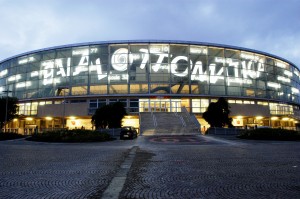Palazzo dello Sport
Primary tabs
 Designers: P.L. Nervi, M. Piacentini.
Designers: P.L. Nervi, M. Piacentini.The Palazzo dello Sport, also known as PalaEur from the name of the district that houses it, is a multi-purpose, multi-functional structure that, with its approximately 12,000 available seats, is able to host sporting, business and music events.
Designed by Pier Luigi Nervi, it is one of the most representative architectural structures of the Twentieth century. The facility, which, like the two sporting structures located nearby, Piscina delle Rose and the Velodrome, was built for the Games of the XVII Olympiad in 1960, still represents an important reference point in the city's sporting and entertainment life. Located in the upper part of the delightful Giardino delle Cascate, Palazzo dello Sport features a circular body approximately 100 m in diameter, glazed all round, and is characterised by the architectural plasticity of its interior. The building does not have a façade as such; it is only when you enter it that it is possible to see how the element with the greatest impact is the flattened dome that covers the entire structure: Nervi, cleverly modelling the reinforced concrete into variable section pillars, created both an aesthetic and a structural masterpiece.
Known today as the PalaLottomatica from the name of its title-sponsor, it has been managed since 2003 by All Events S.p.A., a company in the ForumNet Group, which since 2001 has also carried out its renovation. Thanks to this management it has become a member of the European Arenas Association (EAA), which unites the 32 main European polyfunctional structures, the only structure in Italy to do so apart from the Mediolanum Forum in Milan, which is also part of the ForumNet Group.
POINTS OF INTEREST
Customisation of the large external window and lighting of the outer glass drum, using fluorescent lamps, was the work of the architect Massimiliano Fuksas, who drew his inspiration from Neapolitan "smorfia" (in which every object corresponds to a number).
The location was extremely lucky for the Italian boxing squad, as three national athletes won gold medals: Francesco De Piccoli at heavyweight, Giovanni Benvenuti at welterweight and Francesco Musso at featherweight.
The engineer P.L. Nervi has created other structures used for sport, with close structural similarities to Palazzo dello Sport in EUR: foremost among these is the Norfolk Scope Arena (Virginia - USA) built between 1968 and 1971 and Palazzetto dello Sport in Rome, built along Via Flaminia during the same period as the complex in EUR.
